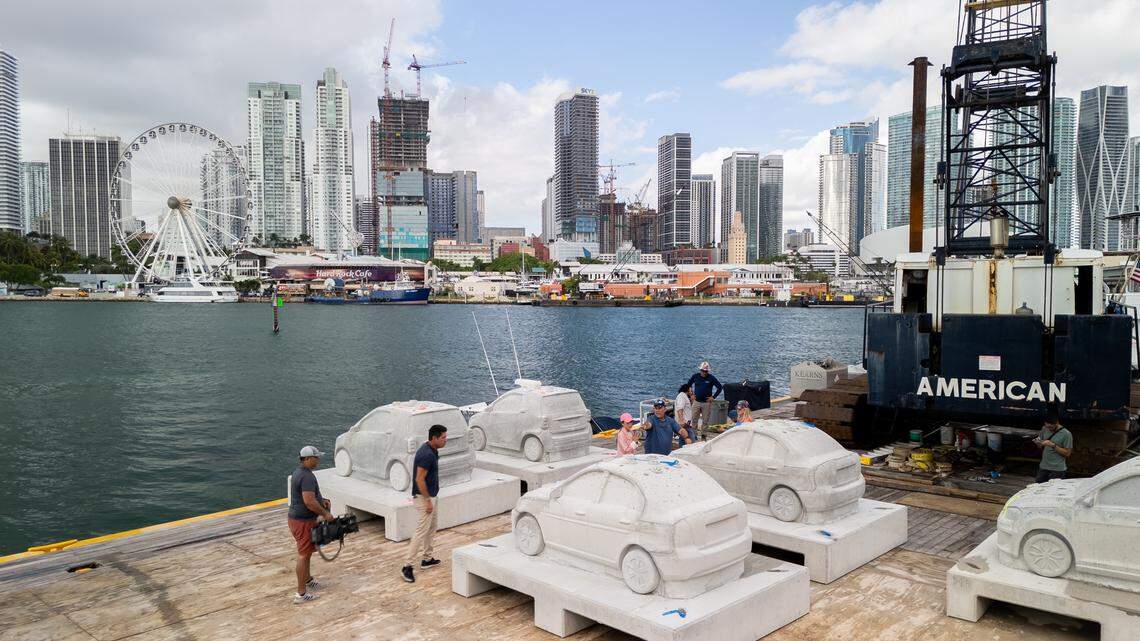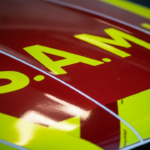For premium support please call:
For premium support please call:
A nearly life-size car made of concrete weighing over 14 tons was slowly lowered to the ocean floor on Monday, just a short swim from the sands of Miami Beach.
It’s the first of a small fleet of similar cars — 22 in all — that make up the initial installation of an ambitious 11-phase project called REEFLINE, which eventually aims to create an underwater sculpture trail along the entire seven-mile length of Miami Beach.
The project is designed as a unique blend of art, tourism and climate resilience. The sculptures by individual artists are intended to draw snorkelers, provide habitat for fish, host coral restoration efforts and help protect the city’s beachfront from storm surge.
The cars — which will sit in 20 feet of water in a line to represent traffic jams that are all too routine in South Florida — allude to both our car-centric culture and the risks of climate change, said Ximena Caminos, founder and artistic director of REEFLINE.
“To me it’s a symbol from transportation to transformation,” Caminos said. “Transportation has created such harm to the environment, and this is transforming that, or using it, if you want, as a vehicle for transformation and regeneration, and transforming that symbol to something that is actually a platform for corals, for marine life, to thrive on.”
The underwater traffic jam — designed by artist Leandro Erlich — also has a modern-day “Atlantis” feel to it, she said. That would be the mythical city lost to the sea eons ago.
The concrete cars were designed to become homes for thousands of soft corals. Their hoods are covered with special plugs where 2,200 corals grown at the Miami Native Coral Lab in Allapattah will be screwed in. The corals come in shades of purple, green and yellow, with some featuring branching arms and others that look like delicate feathers.
Scientists from the Rescue a Reef program also plan to test their coral species on the cars. “We want this to be a playground for scientists to come and test their coral,” said Camino.
The installation site, between 4th and 5th streets off Miami Beach, is a sandy stretch that once held a thriving reef. It was buried by sand years ago due to dredging, and the project aims to restore what was lost.
Miami Beach is a barrier island, and healthy coral reefs act as natural defenses by breaking up waves, helping to reduce shoreline erosion. The concrete cars were tested in the University of Miami’s wind-wave-storm tank and are built to withstand extreme weather and ocean conditions, Caminos said.
“The REEFLINE installation is more than a stunning fusion of art and science; it’s a critical long-term economic safeguard for Miami Beach,” said Miami Beach Mayor Steven Meiner in a press release.
Getting the cars into place underwater is no small task. They’re incredibly heavy, so the process takes time and precision. First, in the days leading up, divers laid out and marked the exact GPS points on the ocean floor, creating a perfect grid for the underwater traffic jam.
The sculptures are loaded onto a 160-foot construction barge named Charli’s Angel, which is equipped with a massive crane. The crane carefully lowers each car into the water, where commercial divers guide and adjust the placement once it’s near the seafloor.
Only one car was deployed on Monday because of rough seas — it took about an hour to get it placed. After that, the team had to call it a day. According to construction manager John Kearns, the oceans swells became too challenging, moving the barge too much for the crane to operate safely.
“A six-inch shift on the surface means about three feet of movement underwater,” Kearns said.
The crew will try for more tomorrow. After a car is placed, it can take up to 24 hours for all the substrate to settle — so it maybe a week or more before the entire installation is ready for visitors. It’s also not a swim for beginners, with the sculptures nearly 800 feet off the beach and beyond the buoy line keeping boats away. So taking a floating dive flag is essential.
REEFLINE is trying to raise $40 million more to construct the rest of the sculptures. Future designs include sculptures inspired by sea stars and the heart of a blue whale. Miami Beach will host a celebration for the installation at 1 p.m. Tuesday between 4th and 5th Street. You can also catch a live view of the crew working on the barge via the Miami Beach webcam.
Ashley Miznazi is a climate change reporter for the Miami Herald funded by the Lynn and Louis Wolfson II Family Foundation and MSC Cruises in partnership with Journalism Funding Partners.
Advertisement
Advertisement
Advertisement
Advertisement
Advertisement
Advertisement
Advertisement
Advertisement
Advertisement
Advertisement












